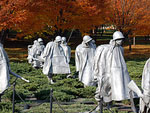At a Glance
Teacher Review
Topics
Website
Features
Duration
Grade(s)
Lesson Format
Download
Examining the Korean War
Students compare two conflicting textbook accounts of the start of the Korean war, and formulate hypotheses for the source of each textbook.
Review

This is a simple, straightforward lesson that not only provides students with the opportunity to analyze causes of the Korean War, but also supplies an excellent opportunity to teach some fundamental principles of historical thinking—namely, that textbooks are historical sources written from a specific point of view, and that differing perspectives produce contrasting narratives of historical events. The lesson begins with a brief discussion of reasons that textbooks—especially textbooks from different countries—might offer differing accounts of the same event. After a brief background lecture on the Korean War [supplemented by slides available here (under lesson 4)], students read two conflicting textbook accounts of the start of the war, and answer a set of guiding questions. The guiding questions are especially helpful at directing students beyond the superficial differences between the documents, encouraging them to pay attention to specific language that might make one document more or less trustworthy than the other. Finally, students are asked to hypothesize which passage came from a North Korean textbook, and which came from a South Korean textbook, again citing specific passages of text to support their hypothesis. One of the greatest strengths of this lesson is the degree to which it is anchored in the documents, and keeps bringing students back to the text itself. Often, students can state an overall sense or impression left by a document, but have difficulty articulating exactly what about the document created that impression. This lesson requires students to zero in on specific language within the text that achieves the authors’ purpose and ultimately reveals something about the source of the document.
Notes
The Korean War Powerpoint Slides referenced in the lesson plan are available here under Lesson 4.
Also see here for more ideas for teaching with textbooks and this additional example of using contrasting textbook accounts in the classroom.
| Field | Criteria | Comments | ||
|---|---|---|---|---|
| Historical Content | Is historically accurate? | Yes |
||
| Includes historical background? | Yes A brief “mini-lecture” at the beginning of the lesson provides some context for the Korean war, including a map provided here (Click on the Powerpoint for Lesson 4). |
|||
| Requires students to read and write? | Yes The lesson requires a close reading of the text; writing requirements are minimal, but could easily be expanded. |
|||
| Analytic Thinking | Requires students to analyze or construct interpretations using evidence? | Yes The two documents included provide varying perspectives on the start of the Korean War. The primary objective of the lesson is for students to analyze these interpretations in order to indentify each document’s source. |
||
| Requires close reading and attention to source information? | Yes This is perhaps the lessons strongest point, as it requires close reading in order to make a hypothesis about source information for two conflicting documents. |
|||
| Scaffolding | Is appropriate for stated audience? | Yes |
||
| Includes materials and strategies for scaffolding and supporting student thinking? | Yes A graphic organizer precedes the guiding questions to help students organize information from each document. |
|||
| Lesson Structure | Includes assessment criteria and strategies that focus on historical understanding? | No |
||
| Defines clear learning goals and progresses logically? | Yes |
|||
| Includes clear directions and is realistic in normal classroom settings? | Yes |
|||